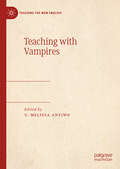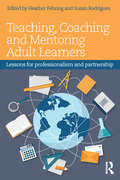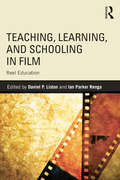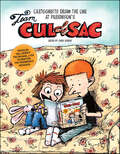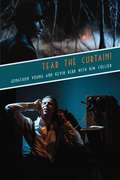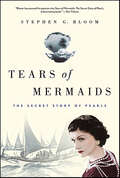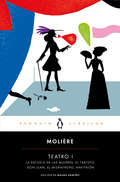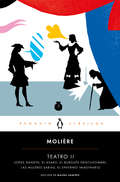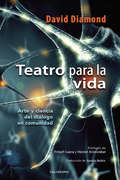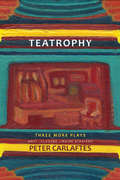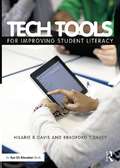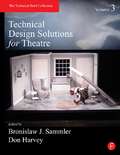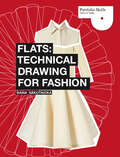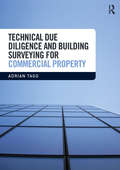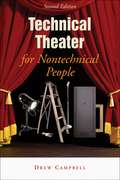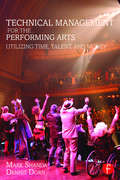- Table View
- List View
Teaching with Comics: Empirical, Analytical, and Professional Experiences
by Robert Aman Lars WallnerThis edited collection analyses the use of comics in primary and secondary education. The editors and contributors draw together global research to examine how comics can be used for critical inquiry within schools, and how they can be used within specific disciplines. As comics are beginning to be recognised more widely as an important resource for teaching, with a huge breadth of topics and styles, this interdisciplinary book unites a variety of research to analyse how learning is 'done' with and through comics. The book will be of interest to educational practitioners and school teachers, as well as students and scholars of comic studies, education and social sciences more broadly.
Teaching with DBQs: Helping Students Analyze Nonfiction and Visual Texts
by Kevin Thomas SmithHelp your students navigate complex texts in history and social studies. This book shows you how to use document-based questions, or DBQs, to build student literacy and critical thinking skills while meeting rigorous state standards and preparing students for AP exams. DBQs can be implemented year-round and can be adjusted to meet your instructional needs. With the helpful advice in this book, you’ll learn how to use DBQs to teach nonfiction and visual texts, including primary and secondary sources, maps, and paintings. You’ll also get ideas for teaching students to examine different points of view and write analytical responses. Topics include: Using the SOAPSETone (Speaker, Occasion, Audience, Purpose, Subject, Evidence and Tone) technique to to analyze visual and nonvisual texts; Teaching students to distinguish between primary and secondary sources; Working with multiple texts and learning to recognize the relationships between them; Formulating DBQs to suit different types of assessment, including short-answer questions, multiple-choice questions, and in-class essay prompts; Evaluating student responses and providing constructive feedback.
Teaching with Digital Humanities: Tools and Methods for Nineteenth-Century American Literature (Topics in the Digital Humanities)
by Jennifer Travis Jessica DeSpainJennifer Travis and Jessica DeSpain present a long-overdue collection of theoretical perspectives and case studies aimed at teaching nineteenth-century American literature using digital humanities tools and methods. Scholars foundational to the development of digital humanities join educators who have made digital methods central to their practices. Together they discuss and illustrate how digital pedagogies deepen student learning. The collection's innovative approach allows the works to be read in any order. Dividing the essays into five sections, Travis and DeSpain curate conversations on the value of project-based, collaborative learning; examples of real-world assignments where students combine close, collaborative, and computational reading; how digital humanities aids in the consideration of marginal texts; the ways in which an ethics of care can help students organize artifacts; and how an activist approach affects debates central to the study of difference in the nineteenth century.
Teaching with Vampires (Teaching the New English)
by U. Melissa AnyiwoThis edited volume provides pedagogical tools for those who teach – and would like to teach – with the most iconic of monsters: the vampire. Vampires are showing up with increasing frequency in the college classroom and there are a growing number of courses devoted solely to the Undead. This collection draws from a diverse range of teaching approaches, including the theoretical framing of vampire texts in a broad range of settings, that demonstrate the myriad of ways vampires are used to teach about marginalization, empathy, and inspire social justice. With chapters from global scholars, this essential text illustrates the burgeoning field of vampire studies and the popularity in classrooms at every level around the world, from gothic fiction to television courses.
Teaching, Coaching and Mentoring Adult Learners: Lessons for professionalism and partnership
by Heather Fehring Susan RodriguesThe challenge for those coaching, mentoring, supervising or teaching adults is to design and deliver high-quality programmes that encompass a blend of teaching and learning approaches and strategies, that are constructed for adult learners in multiple educational environments and that cater for the diversity of adult learners’ needs. Adult learners are complex individuals who come to the learning process with a multitude of different experiences. Teaching, Coaching and Mentoring Adult Learners helps practitioners step up to this challenge by developing the skills needed to share their expertise with adult learners and engage them in new transformative practices. This book also forms a timely contribution to the current period of evolution in adult education, where extreme changes in the nature and scope of work and the globalisation of work and life are influencing learning. The shift in adult education addressed in this book includes: the globalisation of the workforce and the cultural impact on adult, tertiary and further education the relationship established between adult educators and adult learners provision of adult education and professional development by private and major multimedia and corporate interests occupations boundaries between professions and between skilled and unskilled work assessing adult learners’ needs and adapting strategies to meet the perceived needs of adult learners in medicine, education, psychology and industry designing learning experiences to maximise the processing of complex conceptual knowledge and then transforming the knowledge to fit new learning environments the role of new technologies of learning in adult and vocational learning. This book provides research-based insight into the expectations and the value of the coach, mentor, tutor and supervisor roles and combines research with strategic guidance to support the implementation of innovative techniques through case studies, strategies and methodologies in teaching and learning in higher education and professional learning. Bringing together insights from an expert range of international contributors, this text will be invaluable to higher education professionals and those involved in supervising, coaching and mentoring in the workforce.
Teaching, Learning, and Schooling in Film: Reel Education
by Ian Renga Daniel ListonFilms about education provide many of the most popular interpretations of what teaching and learning mean in schools. An analysis of this medium reveals much about the historical, cultural, political, and philosophical dimensions of education. Timely and engaging, this book fills a gap for scholarly and informed public commentary on the portrayal of education in film, offering a wide range of conceptual and interpretive perspectives. Teaching, Learning, and Schooling in Film explores several key questions, including: What does it mean to be a good teacher? How do these good teachers instruct? When is and what makes teaching complex? What constitutes learning? Do educational reforms work? The book’s interdisciplinary group of contributors answers these important questions in essays highlighting Hollywood, independent, and documentary films. Prospective and practicing teachers will engage with the thought-provoking educational issues raised in this book and gain insight into the complexities of teaching and learning portrayed in film.
Team Cul de Sac: Cartoonists Draw the Line at Parkinson's
by Chris SparksWhen Richard Thompson, creator of the cartoon strip Cul de Sac, learned that he had Parkinson&’s disease, the entire cartoon community was moved. From other cartoonists to fans, the urge to &“do something&” was overwhelming. Enter Chris Sparks, friend of and webmaster for Richard, who came up with the idea of joining the Team Fox effort. Having read two of Michael J. Fox&’s books, he knew about the foundation, which made him think of creating a Team Cul de Sac to honor Richard and to raise money for and awareness about PD. He set up the team with the foundation and began the quest to create a book that contributors would donate their original art to be included in the book and to be auctioned off later. All of the auction&’s and a portion of the book's profits will be donated to Team Fox. The response to Chris&’s call for art has been impressive. From indie cartoonists to noted syndicated, editorial, and magazine cartoonists to graphic novel artists, illustrators, and sheer Cul de Sac fans, the assortment of cartoon styles paying homage to Cul de Sac and Richard Thompson in Team Cul de Sac is truly inspiring.
Tear the Curtain!
by Jonathon Young Kim Collier Kevin KerrIn this psychological thriller set in a fictionalized 1930s Vancouver, Alex Braithwaite, a troubled but passionate theatre critic, believes he has found the legendary Stanley Lee, director of the infamous avant-garde theatre "The Empty Space." Alex becomes convinced that this man's radically subversive ideas are what the artistic community of the city needs to shatter audience complacency. In his pursuit of the truth behind Stanley Lee's mysterious disappearance and his artistic ideas, Alex becomes caught between the warring factions of two prominent mob families - one controlling the city's playhouses, the other its cinemas, but both ensnared by the Empty Space Society. At the dawn of the Talkies, can Alex tear through the artifice of these art forms in time to save the city's art community from ripping itself apart?The play's collaborators found inspiration within the walls of Vancouver's Stanley Theatre, a space that has a dual history as a cinema and vaudeville house. Fittingly, this gritty film-noir production became an exploration of the two kinds of art and how they affect the audience. Tear the Curtain! explores global issues that consider what we want from art: to be shocked and surprised or for order to be restored.Cast of 2 women and 8 men.
Tears of Mermaids: The Secret Story of Pearls
by Stephen G. BloomA round, luminescent pearl is the simplest and most perfect gem. Columbus sought-and found-this precious jewel coveted by his Spanish sovereigns, sparking popularity throughout Europe. Fashion icons Jacqueline Kennedy, Princess Grace, and Michelle Obama cherished them, making them iconic. And designer Coco Chanel raised them to new heights, bringing pearls- fake and real-to women everywhere. In Tears of Mermaids, Stephen G. Bloom travels 30,000 miles in an effort to trace a single pearl-from the moment a diver off the coast of Australia scoops an oyster containing a single luminescent pearl from the ocean floor to the instant a woman fastens the clasp of a strand containing the same or Bloom chronicles the never-before-told saga of the global pearl trade by gaining access to clandestine outposts in China, the Philippines, French Polynesia and Australia. He infiltrates high-tech pearl farms guarded by gun-toting sentries, farms for pearls in rural China, and even goes backstage at Christie's for a fast and furious auction of the most expensive pearl ever sold. Teeming with rogue humor and uncanny intelligence, Tears of Mermaids weaves a nonstop detective story whose main character is the world's most enduring jewel.
Tears of Mermaids: The Secret Story of Pearls
by Stephen G. BloomA round, luminescent pearl is the simplest and most perfect gem. Columbus sought—and found—this precious jewel coveted by his Spanish sovereigns, sparking popularity throughout Europe. Fashion icons Jacqueline Kennedy, Princess Grace, and Michelle Obama cherished them, making them iconic. And designer Coco Chanel raised them to new heights, bringing pearls— fake and real—to women everywhere. In Tears of Mermaids, Stephen G. Bloom travels 30,000 miles in an effort to trace a single pearl—from the moment a diver off the coast of Australia scoops an oyster containing a single luminescent pearl from the ocean floor to the instant a woman fastens the clasp of a strand containing the same orb. Bloom chronicles the never-before-told saga of the global pearl trade by gaining access to clandestine outposts in China, the Philippines, French Polynesia and Australia. He infiltrates high-tech pearl farms guarded by gun-toting sentries, farms for pearls in rural China, and even goes backstage at Christie's for a fast and furious auction of the most expensive pearl ever sold. Teeming with rogue humor and uncanny intelligence, Tears of Mermaids weaves a nonstop detective story whose main character is the world's most enduring jewel.
Teatro
by Albert CamusLa cuatro grandes obras de teatro originales de Albert Camus reunidas en un solo volumen, con un prólogo inédito del autor El presente volumen reúne las cuatro obras de teatro originales de Albert Camus: El malentendido (1944), Calígula (1945), El estado de sitio (1948) y Los justos (1949). Todas pertenecen a lo que podría llamarse el teatro moral o de ideas, relacionado formal y temáticamente con la tragedia clásica, a la que el autor era muy afecto. Sus temas y ambientes abarcan desde el sino trágico de una familia en plena Segunda Guerra Mundial hasta los ataques terroristas de un grupo de revolucionarios rusos, pasando por un brote de peste en una Cádiz imaginaria, o una recreación histórica de los excesos del tirano romano Calígula. Pero Camus sabía que al reflejar momentos históricos todo artista acaba hablando del presente. Así pues, en estas obras escritas a caballo de la Segunda Guerra Mundial encontramos sus preocupaciones habituales sobre el absurdo, la rebeldía, la sociedad y el individuo modernos. El autor ha dicho:«¿Por qué hago teatro? Pues bien, a menudo me lo he preguntado. Y la única respuesta que he podido dar hasta ahora parecerá de una trivilidad descorazonadora: simplemente porque el escenario de un teatro es uno de los lugares del mundo donde soy feliz. El teatro me ofrece la comunidad que necesito [...] Aquí todos estamos vinculados los unos a los otros sin que nadie deje de ser libre o casi: ¿no es una buena fórmula para la sociedad futura?»
Teatro I: La escuela de las mujeres / El tartufo / Don Juan / El misántropo / Anfitrión
by MolièreUno de los mayores dramaturgos europeos en una edición magistral a cargo de Mauro Armiño. El presente volumen, primero de dos dedicados al teatro de Molière, reúne cinco de sus grandes comedias, estrenadas entre 1662 y 1668, cuando su compañía conquistó los escenarios de París. En La escuela de las mujeres tuvo su primer gran éxito; con El Tartufo desató el escándalo; en Don Juan enriqueció un nuevo mito europeo; con El misántropo ofreció un agudo análisis de la necedad; y en Anfitrión parodió los entresijos de la corte. En conjunto, estas piezas geniales no solo exponen las flaquezas humanas, sino que castigan con el ridículo a quienes más a salvo se creen de ellas. Nuestra edición, a cargo de Mauro Armiño, uno de los mejores traductores y críticos literarios de la actualidad, se completa con una espléndida introducción, notas explicativas y noticias sobre el contexto histórico-literario de las comedias.
Teatro II: Georges Dandin / El avaro / El burgués gentilhombre / Las mujeres sabias / El enfermo imaginario
by MolièreSegundo tomo de las obras esenciales de Molière, uno de los mayores dramaturgos de la literatura europea, a cargo de Mauro Armiño El presente volumen, con el que completamos nuestra selección del teatro de Molière, reúne cinco de sus grandes comedias, estrenadas entre 1668 y 1673, durante el último lustro de vida del autor. Jorge Dandín castiga los sueños de ascenso social; El avaro ataca la codicia de la burguesía en el siglo xvii; El burgués gentilhombre satiriza los códigos huecos de la aristocracia; Las mujeres sabias pone el punto de mira en la pedantería; y El enfermo imaginario ironiza sobre los límites subjetivos de la salud. En estas piezas tardías, el inigualable comediógrafo amplía su registro hasta alcanzar por momentos el sentimiento trágico de la vida. Nuestra edición, a cargo de Mauro Armiño, uno de los grandes traductores y críticos literarios de la actualidad, se completa con notas explicativas y cuidadas noticias sobre el contexto histórico-literario de las comedias.
Teatro para la vida: Arte y ciencia del diálogo en comunidad
by David DiamondEl arte y la ciencia del diálogo basado en la comunidad. Teatro es un lenguaje primario que solía hablar todo el mundo; incluso la «comunidad viva». Entrelazando la teoría de sistemas y las extraordinarias ideas innovadoras de Fritjot Capra, el legado revolucionario del Teatro del Oprimido de Augusto Boal y sus varias décadas de experiencia práctica creando teatro con comunidades por el mundo, David Diamond ha escrito este libro rompiendo silos y abrazando la complejidad de la vida real. Teatro para la vida intenta responder algunas preguntas: desde la perspectiva biológica y sociológica, ¿cómo puede estar viva una comunidad? ¿Cómo diseñamos una práctica del teatro para trabajar conscientemente con comunidades vivas, ayudándoles a contar sus historias? ¿Cómo lo conseguimos sin demonizar a los personajes con quienes disentimos? ¿Debemos luchar permanentemente para derrotar a un flujo infinito de opresores o podemos imaginar un mundo en el que dejemos de crearlos? ¿Por qué es esto importante? ¿Qué deberíamos esperar (positivo y negativo) al hacer este trabajo? ¿Qué juegos y ejercicios prácticos podemos usar para despertar la conciencia grupal? ¿A quién le puede interesar el Teatro para la vida? Artistas, promotores del desarrollo comunitario, educadores y activistas; trabajadores en servicios sociales, mediación, resolución de conflictos y servicios de salud; cualquiera interesado en encontrar nuevas formas de explorar la intersección entre arte, cultura y justicia social.
Teatrophy
by Peter CarlaftesIn Teatrophy: Three More Plays, critically-acclaimed playwright/author/poet Peter Carlaftes offers a trio of brilliant and intense modern plays that inspire on both page and stage. In "Anti,” Carlaftes explores a frightening future-in which government surveillance and data mining is the norm-through the eyes of a theater director on the verge of giving up hope. The chilling psycho-sexual drama "Closure” examines the relationship between a woman whose sister was abused a child, and the rapist-murderer that stalks her outside her therapist’s office. In the tender and humorous "Inside Straight,” characters must confront their lovers’ sudden shift in sexual orientation as a gay man and a lesbian woman discover they are attracted to each other. The San Francisco Bay Guardian praised the play: "Inside Straight is a comedy of eros! . . . A restive heart knows no logic or permanence. ” All three plays share a passion for beautifully drawn, full characters and powerful moments that force them to expose the true identity they work so hard to hide. As the SF Weekly raved, "As with Strindberg, Beckett or even Sartre, Carlaftes’ message seems to be something we intuit, like music. ”
Tech Tools for Improving Student Literacy
by Hilarie B. Davis Bradford T. DaveyTechnology isn’t just fun to use in the classroom, it can also make real improvements in students’ literacy development. In this book, authors Hilarie Davis and Bradford Davey show you how and why to use tech tools to help enhance the teaching of reading, writing, speaking, listening, and viewing. These tools can be used in English/Language Arts and across the subject areas to promote literacy throughout your school. Special Features: Practical classroom examples from a variety of content areas Connections to specific Common Core State Standards "Using the Technology" boxes with step-by-step guidance on using a tool Screenshots that show how the tools work Strategies to help you use the tools effectively with students
Technical Design Solutions for Theatre Volume 3: The Technical Brief Collection Volume 1
by Bronislaw J Sammler Don HarveyTechnical Design Solutions for Theatre is a collection of single-focus articles detailing technical production solutions that have appeared in The Technical Brief Collection, a publication of the Yale School of Drama’s Technical Design and Production Department. The primary objective of the publication was to share creative solutions to technical problems so that fellow theatre technicians can avoid having to reinvent the wheel with each new challenge. The range of topics includes scenery, props, painting, projections, sound, and costumes. Each article describes an approach, device, or technique that has been tested onstage or in a shop. Great reference of tips and solutions to persistent technical challenges in theatre production Solutions provided by contributors from over twenty different producing organizations Ten years of The Technical Brief Collection articles bound in each of three volumes A comprehensive index to all three volumes included in Volume III
Technical Design Solutions for Theatre: The Technical Brief Collection Volume 1
by Don Harvey Bronislaw J. SammlerThe Technical Brief is a collection of single-focus articles on technical production solutions, published three times a year by the prestigious Yale School of Drama. The primary objective of the publication is to share creative solutions to technical problems so that fellow theatre technicians can avoid having to reinvent the wheel with each new challenge. The range of topics includes scenery, props, painting, electrics, sound, and costumes. The articles each describe an approach, device, or technique that has been tested on stage or in a shop by students and professionals. Some articles included: Growing Flowers on Stage; Break-Away Glass; Photo-Murals for the Stage; Quiet Wire-Rope Curtain Track; Free Standing Curved Stairs; A Measured Approach to Kerfing; A Low-Voltage Remote Controller for Special Effects; Toggle-Clamp Locks; Comparing Four Plastics as Scenery Glides; Low Pressure Air Casters; A Simple Lift Jack; Using a Piano to Create a Reverberation Effect; Horn-Hat Mics for Sound Reinforcement
Technical Design Solutions for Theatre: The Technical Brief Collection Volume 2
by Don Harvey Bronislaw J. SammlerThe Technical Brief is a collection of single-focus articles on technical production solutions, published three times a year by the prestigious Yale School of Drama. The primary objective of the publication is to share creative solutions to technical problems so that fellow theatre technicians can avoid having to reinvent the wheel with each new challenge. The range of topics includes scenery, props, painting, electrics, sound and costumes. The articles each describe an approach, device, or technique that has been tested on stage or in a shop by students and professionals. Some articles included are: Building Authentic Elizabethan Ruffs; Simple and Inexpensive Stained Glass; A Quick-Load Floor Pulley Design; A Simple Approach to Stretching Drops; Flexi-Pitch Escape Stairs; Spot-Welding Scrim with Sobo; Handrail Armatures for a Grand Staircase; The Triscuit-Studwall Deck System; A Frameless Turntable; Stand on Stage: Minimum Weight, Maximum Effect; A Self-Paging Cable Tray; Roller Chain Turntable Drives; A Bench-Built XLR Cable Tester
Technical Design Solutions for Theatre: The Technical Brief Collection Volume 2
by Bronislaw J. SammlerThe Technical Brief is a collection of single-focus articles on technical production solutions, published three times a year by the prestigious Yale School of Drama. The primary objective of the publication is to share creative solutions to technical problems so that fellow theatre technicians can avoid having to reinvent the wheel with each new challenge. The range of topics includes scenery, props, painting, electrics, sound and costumes. The articles each describe an approach, device, or technique that has been tested on stage or in a shop by students and professionals. Some articles included are: Building Authentic Elizabethan Ruffs; Simple and Inexpensive Stained Glass; A Quick-Load Floor Pulley Design; A Simple Approach to Stretching Drops; Flexi-Pitch Escape Stairs; Spot-Welding Scrim with Sobo; Handrail Armatures for a Grand Staircase; The Triscuit-Studwall Deck System; A Frameless Turntable; Stand on Stage: Minimum Weight, Maximum Effect; A Self-Paging Cable Tray; Roller Chain Turntable Drives; A Bench-Built XLR Cable Tester
Technical Drawing for Fashion (Portfolio Skills)
by Basia SzkutnickaTechnical Drawing for Fashion explains how to create a technical fashion drawing using a simple and straightforward step-by-step method, explained for those who wish to use Adobe Illustrator as well as for those who prefer to draw by hand. The second part of the book presents over 600 technical drawings of garment types, styles and construction details, the basic key shapes of which are shown alongside a specially created and photographed calico toile. Accompanying each illustration is a list of all the terms by which that garment is known. This unique presentation illustrates the relationship between the three dimensional garment and the two-dimensional drawing, allowing readers to really understand how to render technical drawings.
Technical Drawing for Fashion: A Complete Guide
by Basia SzkutnickaTechnical Drawing for Fashion explains how to create a technical fashion drawing using a simple and straightforward step-by-step method, explained for those who wish to use Adobe Illustrator as well as for those who prefer to draw by hand. The second part of the book presents over 600 technical drawings of garment types, styles and construction details, the basic key shapes of which are shown alongside a specially created and photographed calico toile. Accompanying each illustration is a list of all the terms by which that garment is known. This unique presentation illustrates the relationship between the three dimensional garment and the two-dimensional drawing, allowing readers to really understand how to render technical drawings.
Technical Due Diligence and Building Surveying for Commercial Property
by Adrian TaggTechnical Due Diligence and Building Surveying for Commercial Property is the first book to introduce the process of technical due diligence (TDD) and examine the role of the building surveyor within the commercial property sector. The book outlines the processes that the surveyor must go through when performing a TDD inspection and report and, most importantly, covers in detail the typical pathology and defects encountered during TDD. Performing a TDD survey involves collecting, analysing and reporting on a huge amount of information, often under specific contractual conditions. The book covers everything the surveyor needs to know in order to do a proper job and includes analysis of materials, life cycles and potential defects on an elemental basis, with detail on individual components where necessary. Coverage includes: • an introduction to the TDD process and types of commercial buildings encountered • chapters outlining the life cycle and defects of: structures, roofs, facades, finishes and services • hundreds of illustrations and photographs of defects, real-world case studies and suggestions for further reading • a final chapter covering legal issues and technical details. This book fills a clear gap in the literature and is the first fully illustrated book on TDD dedicated to commercial building stock. It will help students and professionals to understand the process, the science involved and the reasons why defects occur, as well as their evolution and long-term impact.
Technical Film and TV for Nontechnical People
by Drew CampbellTechnical Film and TV for Nontechnical People introduces film students, actors, producers and other nontechnical film people to the technical aspects that everyone working on a film set should know. Author Drew Campbell is a lighting and sound designer for Universal Studios who started out in theater and who was struck by the complex technical procedures and idiosyncratic expressions that he encountered on his first weeks on the set. Topics explained: Who does what on a film set: the roles of technical and non-technical team membersSeeing a script: turning a story into a storyboard and then into a productionShooting on film or video: when each format is best used The parts of a camera: how it functions and how actors can best cooperate with itSound: the process of recording and editingShooting: the geography and schedule of a set and "getting the shot" Postproduction: editing, continuity, and the dailies
Technical Management for the Performing Arts: Utilizing Time, Talent, and Money
by Mark Shanda Dennis DornTechnical Management for the Performing Arts: Utilizing Time, Talent, and Money is a comprehensive guide to the tools and strategies of a successful technical manager. This book demonstrates how you can coordinate personnel, raw materials, and venues, all while keeping a production on a tight schedule and within budget. From concept to realization, through nightly performances, Technical Management for the Performing Arts focuses on the technical and organization skills a technical manager must demonstrate, and emphasizes the need for creativity and interpersonal management of a team.



